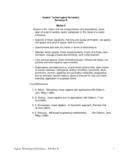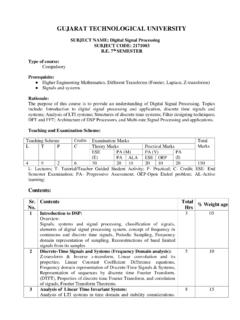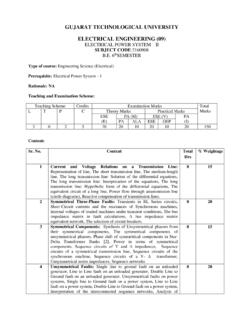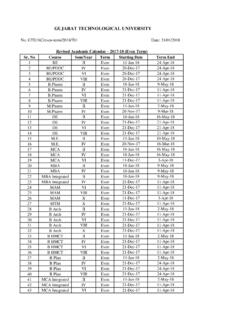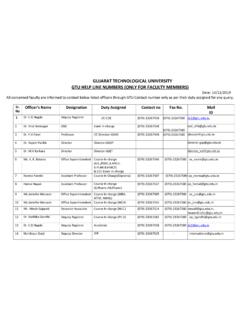Transcription of Gujarat Technological University BE- Sem - I Mathematics-I
1 Gujarat Technological University Sem I 1 Gujarat Technological University BE- Sem - I Mathematics-I Review of limits, continuity, differentiability. Mean value theorem, Taylors Theorem, Maxima and Minima. Riemann integrals, Fundamental theorem of Calculus, Improper inte- grals, applications to area, volume. Convergence of sequences and series, power series. Partial Derivatives, gradient and directional derivatives, chain rule, maxima and minima, Lagrange multipliers. Double and Triple integration, Jacobians and change of variables for- mula. Parametrization of curves and surfaces, vector Fields, line and surface integrals. Divergence and curl, Theorems of Green, Gauss, and Stokes.
2 Texts/References 1. Hughes-Hallett et al., Calculus - Single and Multivariable (3rd Edition), John-Wiley and Sons (2003). 2. James Stewart, Calculus (5th Edition), Thomson (2003). 3. T. M. Apostol, Calculus, Volumes 1 and 2 (2nd Edition), Wiley Eastern 1980. 4. G. B. Thomas and R. L. Finney, Calculus and Analytic Geometry Gujarat Technological University Sem I 2 Chemistry 1. Water Technology : Introduction, sources of water Impurities in water, hard and soft water, Degree of hardness, Types of hardness, Scale and sludge formation in boiler Boiler corrosion. Caustic embrittlements, Priming and Foaming, Softening of water.
3 Potable water, Break point of chlorination, Desalination of Brackish water etc. 2. Metals and alloys : Introduction, Physical properties of metals, cast iron, wrought iron, steel, Heat treatment of steel. Definition of alloy, purpose of making alloys. Classification of alloys. Alloys of steel and its applications. Non-Ferrous alloys and its industrial applications. 3. Corrosion and its inhibition : Introduction, Theories of corrosion, Types of corrosion, Protection of metals from corrosion organic and inorganic materials, Inhibitors, Cathodic protection. 4. Fuels and Combustion : Definition, types of fuel solids, liquids, gaseous and Nucleon fuels.
4 Calorifio Value, Characteristics of good fuel. solid fuels coal, coke. Analysis of coal ultimate and proximate Liquid fuel Petroleum. Refining of Petroleum by Fractional distillation. Gaseous fuel coal-gas, bio gas produces gas and water gas. & CNG. 5. Lubricants : Definition : Types of lubrication, classification of lubricants and their properties . Functions of lubricants. 6. Cements : Introduction Manufacturing of Lime, Gypsum and Cement and their properties . Manufacturing of Portland cement, chemical composition of cement chemical constituents of Portland cement, Setting and hardening of cement.
5 7. Polymers and Plastics : Introduction, Definition of Polymer. Types of Polymers, Types of Polymerization reactions and their mechanism. Plastics, Classification of plastics Thermo plastics and Thermo setting plastics. Molding constituents of plastics Engineering properties and uses of plastics. Definition of Rubber, Types of Rubber, Vulcanization of rubber. Application of Rubber. 8. Multidisciplinary nature of Environment Study : Introduction, Nature of environment and its problem due to over utilization of natural sources. Environmental degradation Green house effect, acid rain, Ozone depletion, Photochemical smog.
6 Environmental problems in India, Environment management and laws. Public awareness. Gujarat Technological University Sem I 3 9. Natural and Synthetic Fibers : Introduction Definition of Fiber, Types of fibers Natural, semi synthetic, synthetic fibers. Physical properties of fibers. Essential requirement for fiber for formation. Preparation, properties and uses of Cellulose acetic, Viscose Rayon, Nylon, Polyesters acrylic, Glass fibers etc. Differentiate between wool and silk fibers. Spinning processes Melt and Wet spinning. 10. Chemical aspect of Biotechnology : Definition, Benefits through biotechnology Agriculture, Food quality, Medicines etc.
7 Fermentation, Fermentation processes, Enzymes and its application in industries. Bio fuels and Bio membrane. 11. Protective Coatings : Introduction, Types of protective coatings metallic, chemical, organic, electroplating. Paints and varnishes Ingredients, properties and uses, Enamels, Lacquers etc. 12. Renewable and Non-renewable energy of sources : Resources of energy, Appraisal resources problems, classification of Natural and renewable resources. Destruction and Conservation. 13. Refractories, Abrasives and Insulators : Definitions of refractories, Abrasives and insulators. properties of refractories.
8 Classification of refractories. Classification, properties and uses of abrasives. Classification, properties and uses of Insulators. 14. Analytical Techniques : Introduction Types of analysis Physical, Chemical and instrumentation. Physical analysis Specific gravity, Melting point, Boiling point, Crystallization. Purification of compounds etc. Chemical analysis Quantitative and Qualitative analysis of organic and inorganic compounds. Instrumental analysis Spectroscopic, Chromatographic PH measurement, Conductinity, Turbidity etc. The topics No.
9 12, 13 and 14 are to be taught during practical hours as a part of tutorial. References : 1. Engineering Chemistry by Jain and Jain Publisher Dhanpat Rai Publishing Co. 2. Engineering Chemistry by Dr. Agrawal Khanna Publishers Delhi 3. Engineering Chemistry by N. Krishnamurthy, P. Vallinaygam and D. Madhavan Publisher Prentice Hall of India Pvt. Ltd. New Delhi 4. Engineering Chemistry by R. Gopalan, D. Venkappaya and Sulochana Nagarjan 5. Engineering Chemistry by C. Parameswara Murthy, Agrawal and Andra Naidu, Publication, Hyderabad Gujarat Technological University Sem I 4 6.
10 Environmental Science by Y. Anjaneyulu Publishers, Hyderabad 7. Environmental Studies and Disaster Management by Shah, Shah and Gopal 8. Engineering Chemistry by B. Sivsankar The Grawhill Companies, New Delhi Gujarat Technological University Sem I 5 Physics 1) Architectural Acoustics Classification of Sound : Loudness Weber Fechner law Decibel Absorption Coefficient Reverberation Saline s formula Factors affecting acoustics of buildings and their remedies. 2) Ultrasonic Introduction, production, properties and detection of ultrasonics.
